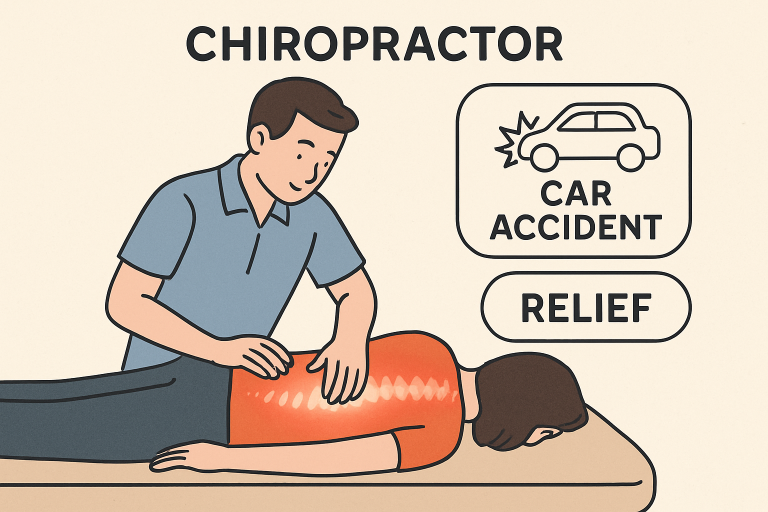Car accidents affect approximately 1.19 million lives annually, according to the World Health Organization, with countless others suffering injuries that manifest months or even years later. The jarring impact of a collision—whether a high-speed crash or a minor fender bender—sends shockwaves through your musculoskeletal system that aren’t always immediately apparent.
Your body’s natural adrenaline response can mask severe injuries for hours or days after an accident. What feels like minor soreness today could develop into chronic pain, reduced mobility, or permanent spinal dysfunction tomorrow. This is where chiropractic care becomes not just beneficial, but essential for complete recovery.
Unlike conventional medical treatments that often rely on pain medications to mask symptoms, chiropractic intervention addresses the root cause of post-accident injuries. Through targeted spinal adjustments, soft tissue therapy, pelvic floor treatment, and rehabilitative techniques, chiropractors help restore your body’s natural alignment and accelerate healing at the cellular level.
Understanding What Really Happens to Your Body During a Car Accident
The Immediate Physical Response
The moment of impact triggers a complex physiological cascade within your body. Your muscles instantaneously tighten in a protective response, creating sudden tension that can lead to:
- Muscle strain and micro-tears in soft tissues that X-rays cannot detect
- Ligament sprains from the forceful stretching of connective tissues
- Joint displacement as vertebrae shift out of proper alignment
- Nerve compression from swelling and structural changes
Your adrenal glands simultaneously flood your system with cortisol and adrenaline. While this “fight or flight” hormone helps you handle the crisis, it also suppresses pain signals, creating a dangerous illusion of wellness that prevents many accident victims from seeking immediate care.
Hidden Injuries That Develop Silently
Research shows that many auto accident injuries don’t manifest symptoms until 24-72 hours post-collision, and some remain dormant for weeks. These “hidden injuries” include:
Whiplash: The most common auto injury occurs when your head snaps back and forth rapidly, causing cervical spine damage. Symptoms include persistent neck pain, reduced range of motion, headaches originating at the skull base, dizziness, and cognitive difficulties.
Spinal Misalignment: Even low-speed collisions can shift vertebrae out of position, leading to nerve interference, muscle imbalances, postural problems, and chronic discomfort that worsens over time.
Soft Tissue Damage: Muscles, tendons, and ligaments suffer micro-tears that create inflammation, scar tissue formation, decreased flexibility, and long-term mobility restrictions.
Nerve Compression: Surrounding tissues can apply excessive pressure on nerves, causing numbness or tingling in extremities, radiating pain down arms or legs (sciatica), weakness in affected limbs, and burning sensations.
5 Critical Warning Signs You Need Chiropractic Care After an Accident
1. Persistent Neck or Back Pain
Lower, middle, or upper back pain following a collision indicates potential spinal misalignment or soft tissue injury. Even mild discomfort shouldn’t be ignored, as untreated spinal issues can lead to degenerative conditions 20-30 years later.
Why Chiropractic Helps: Gentle spinal adjustments realign vertebrae, relieve nerve pressure, and restore proper biomechanics. Chiropractors use targeted manipulation techniques that reduce inflammation and promote natural healing without invasive procedures.
2. Stiffness or Limited Range of Motion
Difficulty turning your head, bending forward, or moving your shoulders signals joint misalignment and muscle tension. This mobility restriction interferes with daily activities and can become permanent without intervention.
Treatment Approach: Chiropractors create personalized treatment plans combining:
- Spinal manipulation to correct alignment
- Soft tissue therapy to release muscle tension
- Therapeutic exercises to rebuild strength and flexibility
- Joint mobilization to restore full range of motion
3. Headaches or Dizziness
Post-accident headaches often result from three sources:
| Headache Type | Cause | Chiropractic Solution |
|---|---|---|
| Tension Headaches | Muscle tightness in neck and shoulders | Soft tissue therapy and cervical adjustments |
| Cervicogenic Headaches | Nerve compression from spinal misalignment | Upper cervical realignment |
| Concussion-Related | Brain trauma from impact | Improved blood flow and nervous system function |
Dizziness may indicate vestibular system dysfunction, inner ear issues from cervical trauma, or reduced blood flow to the brain—all conditions chiropractic care can address through targeted adjustments.
4. Numbness or Tingling in Extremities
These neurological symptoms indicate nerve compression or damage that requires immediate attention. When vertebrae shift out of position, they can pinch nerves that control sensation and function in your arms, hands, legs, and feet.
Sciatica Treatment: For sciatic nerve compression causing pain from lower back through legs, chiropractors employ:
- Specific adjustments to relieve pressure on the sciatic nerve
- Flexion-distraction techniques to decompress spinal discs
- Therapeutic exercises to strengthen supporting muscles
- Anti-inflammatory therapies to reduce tissue swelling
5. Fatigue or Sleep Disturbances
Persistent exhaustion and difficulty sleeping often stem from unresolved pain that prevents restorative rest. Your body heals during deep sleep, making quality rest crucial for recovery.
How Chiropractic Improves Sleep: By reducing pain levels, restoring nervous system balance, improving circulation, and reducing stress hormones, chiropractic care helps patients achieve the deep, healing sleep necessary for tissue repair.
The Science Behind Chiropractic Recovery: 8 Proven Benefits

1. Immediate Pain Relief Without Medication
Chiropractic adjustments provide natural pain reduction by:
- Releasing endorphins, your body’s natural painkillers
- Reducing pressure on pain-sensitive nerves
- Improving joint mechanics to decrease inflammation
- Restoring normal biomechanical function
Clinical Evidence: Studies show that spinal manipulation offers pain relief comparable to medication but without side effects or dependency risks.
2. Reduces Inflammation Throughout the Body
Micro-tears in muscles and ligaments create inflammation that X-rays can’t detect. Chiropractic adjustments trigger the release of anti-inflammatory substances by:
- Realigning the spinal column to reduce tissue stress
- Improving lymphatic drainage to remove inflammatory markers
- Decreasing cytokine production that drives chronic inflammation
- Enhancing circulation to deliver healing nutrients
3. Restores Full Range of Motion
Joint mobility depends on proper alignment and tissue flexibility. Chiropractic care accelerates mobility restoration through:
Progressive Treatment Phases:
| Recovery Phase | Timeline | Focus | Techniques Used |
|---|---|---|---|
| Acute (0-2 weeks) | Initial injury | Pain reduction, inflammation control | Gentle adjustments, ice therapy, rest |
| Rehabilitative (3-8 weeks) | Active healing | Mobility restoration, strength building | Progressive adjustments, exercises, stretching |
| Maintenance (9+ weeks) | Long-term health | Preventing re-injury, optimizing function | Periodic adjustments, lifestyle guidance |
4. Prevents Long-Term Damage and Chronic Conditions
Untreated auto injuries often develop into permanent problems:
- Chronic pain syndromes that resist treatment
- Premature arthritis in damaged joints
- Permanent range of motion restrictions
- Recurring headaches and migraines
- Postural abnormalities affecting quality of life
Early Intervention Benefits: Seeking chiropractic care within 72 hours of an accident reduces chronic pain development by up to 70% compared to delayed treatment.
5. Reduces Scar Tissue Formation
As your body heals, it forms scar tissue in injured areas. While necessary for repair, excessive scarring causes:
- Stiffness and reduced flexibility
- Persistent discomfort during movement
- Decreased strength in affected areas
- Limited athletic performance
Chiropractors use manual therapy techniques to break down excess scar tissue faster than natural healing alone, preserving flexibility and preventing long-term mobility restrictions.
6. Alleviates Whiplash Symptoms Effectively
Whiplash affects the cervical spine’s delicate structures, requiring specialized care. Chiropractic whiplash treatment includes:
- Gentle cervical adjustments to restore alignment
- Myofascial release to address muscle damage
- Rehabilitation exercises to rebuild neck strength
- Postural training to prevent future injury
Recovery Timeline: With consistent chiropractic care, most whiplash patients experience significant improvement within 6 weeks, though complete healing typically requires 3-6 months depending on severity.
7. Addresses Hidden Injuries Missed by Emergency Rooms
Emergency departments excel at identifying life-threatening conditions but often overlook:
- Subtle spinal misalignments
- Soft tissue injuries without fractures
- Early-stage disc problems
- Minor nerve compression
- Muscle imbalances and tension patterns
Chiropractors perform comprehensive physical assessments including:
- Detailed postural analysis
- Range of motion testing
- Palpation to identify tender areas and misalignments
- Orthopedic and neurological examinations
- Movement pattern assessment
8. Provides Drug-Free, Non-Invasive Treatment
Many accident victims receive prescriptions for painkillers or muscle relaxants that only mask symptoms temporarily. These medications carry risks:
Medication Concerns vs. Chiropractic Benefits:
| Pain Medication Approach | Chiropractic Approach |
|---|---|
| Masks symptoms without addressing cause | Treats root cause of pain |
| Risk of dependency and addiction | No dependency risk |
| Potential side effects (stomach issues, drowsiness) | Natural, side-effect-free healing |
| Temporary relief only | Long-lasting results |
| May require increasing doses | Progressive improvement over time |
Advanced Chiropractic Techniques for Accelerated Recovery
Spinal Decompression Therapy
This non-surgical treatment gently stretches the spine to:
- Reduce pressure on compressed discs
- Promote nutrient flow to damaged tissues
- Encourage disc rehydration and healing
- Relieve nerve root compression
Ideal For: Herniated discs, bulging discs, sciatica, and chronic lower back pain.
Platelet-Rich Plasma (PRP) Therapy
PRP involves using concentrated platelets from your own blood to:
- Stimulate tissue repair and regeneration
- Reduce inflammation at injury sites
- Accelerate healing of ligaments and tendons
- Provide long-term pain relief
Clinical Success: When combined with chiropractic adjustments, PRP therapy can reduce recovery time by 30-40% for severe soft tissue injuries.
MLS Cold Laser Therapy
This FDA-cleared technology uses specific light wavelengths to:
- Penetrate deep into damaged tissues
- Reduce inflammation and swelling
- Block pain signals at the cellular level
- Accelerate tissue repair and regeneration
Treatment Duration: Most patients experience pain relief after just 3-5 sessions, with each session lasting 10-15 minutes.
Shockwave Therapy
Acoustic wave technology breaks down scar tissue and stimulates healing through:
- Increased blood flow to injured areas
- Triggering natural tissue regeneration
- Breaking up calcifications and adhesions
- Reducing chronic pain patterns
Electrical Muscle Stimulation (EMS)
Advanced systems like the Matrix by Neuromed use targeted electrical stimulation to:
- Block pain signals from reaching the brain
- Reduce muscle spasms and tension
- Improve circulation to promote healing
- Strengthen weakened muscles
Patient Experience: Many patients report significant pain reduction after their first EMS session, even when complete healing takes longer.
Recovery Timelines: What to Realistically Expect
Factors Influencing Your Recovery Speed
Multiple variables determine how quickly you’ll heal:
Injury Severity:
- Minor soft tissue strains: 2-6 weeks
- Moderate whiplash injuries: 6-12 weeks
- Severe spinal damage: Several months to a year
- Disc herniation with nerve involvement: 3-9 months
Treatment Consistency:
- Attending all scheduled appointments accelerates healing
- Missing sessions can slow progress by 40-50%
- Following home care recommendations is crucial
- Early treatment (within 72 hours) produces best outcomes
Individual Health Factors:
- Age and overall fitness level
- Pre-existing conditions (arthritis, prior injuries)
- Lifestyle habits (smoking, nutrition, activity level)
- Stress levels and emotional well-being
- Compliance with treatment recommendations
Treatment Approach:
- Comprehensive care (combining multiple techniques) vs. single modality
- Advanced technology integration (laser, PRP, shockwave)
- Addressing extremity injuries (shoulders, knees, wrists) alongside spinal care
- Including rehabilitative exercises and lifestyle modifications
Typical Recovery Windows by Injury Type
| Injury Category | Average Recovery Time | Treatment Frequency | Key Success Factors |
|---|---|---|---|
| Mild Soft Tissue Strain | 2-6 weeks | 2-3x weekly initially | Consistent care, home exercises |
| Moderate Whiplash | 6-12 weeks | 3x weekly, tapering to weekly | Early intervention, full compliance |
| Severe Whiplash/Herniated Disc | 3-9 months | 3x weekly, then maintenance | Advanced therapies, lifestyle changes |
| Complex Multi-Level Injury | 6-12+ months | Intensive initial care, ongoing support | Comprehensive treatment, patience |
Important Note: While complete healing takes time, most patients report significant pain reduction within the first 2-3 weeks of consistent chiropractic care.
Maximizing Your Recovery: Essential Self-Care Strategies
During Active Treatment
Stay Consistent with Appointments: Your body heals progressively with each adjustment. Missing sessions disrupts this healing cascade and can set back recovery by weeks.
Follow Home Care Protocols:
- Perform prescribed stretching exercises 2-3 times daily
- Apply ice to injured areas for 15-20 minutes every 2-3 hours during the first 72 hours
- Use heat therapy after initial inflammation subsides (72 hours+)
- Maintain proper posture during all activities
- Avoid positions that aggravate symptoms
Prioritize Quality Sleep:
- Sleep on your back or side with proper pillow support
- Avoid stomach sleeping which strains the neck
- Use a cervical pillow to maintain natural neck curve
- Create a cool, dark sleeping environment
- Establish consistent sleep/wake times
Nutrition for Accelerated Healing
Your body requires specific nutrients to repair damaged tissues:
Anti-Inflammatory Foods:
- Omega-3 fatty acids (salmon, walnuts, flaxseeds)
- Leafy greens (spinach, kale, collard greens)
- Berries (blueberries, strawberries, cherries)
- Turmeric and ginger for natural inflammation control
- Green tea containing powerful antioxidants
Protein for Tissue Repair:
- Lean meats, fish, and poultry
- Eggs and dairy products
- Legumes and beans
- Protein smoothies for easy nutrient absorption
Hydration:
- Drink 8-10 glasses of water daily
- Avoid sugary drinks and excessive caffeine
- Proper hydration keeps spinal discs healthy and promotes toxin elimination
Movement and Exercise Guidelines
Phase 1 (Acute Injury – First 2 Weeks):
- Rest is crucial but avoid complete immobilization
- Gentle range of motion exercises as prescribed
- Short walks (10-15 minutes) if comfortable
- Avoid heavy lifting, twisting, or high-impact activities
Phase 2 (Rehabilitation – Weeks 3-8):
- Progressive strengthening exercises
- Core stabilization work
- Gradual return to normal activities
- Swimming or water therapy for low-impact movement
Phase 3 (Maintenance – Weeks 9+):
- Full exercise program restoration
- Preventive strength training
- Regular stretching routine
- Ongoing chiropractic maintenance care
Real Patient Success Stories: From Pain to Recovery
Case Study 1: Rear-End Collision Whiplash Recovery
Patient Profile: Sarah, 34-year-old marketing executive hit by distracted driver at traffic light
Initial Symptoms:
- Severe neck pain and stiffness
- Daily headaches
- Difficulty sleeping
- Unable to turn head more than 30 degrees
Treatment Protocol:
- 3x weekly chiropractic adjustments for 4 weeks
- Cold laser therapy sessions
- Home stretching program
- Ergonomic workstation modifications
Results: After 6 weeks, Sarah achieved 90% pain reduction, full range of motion restoration, and returned to all normal activities including her favorite yoga classes.
Case Study 2: Multi-Vehicle Highway Accident
Patient Profile: Michael, 52-year-old construction worker involved in chain-reaction highway accident
Initial Symptoms:
- Lower back pain radiating down left leg
- Numbness in foot
- Difficulty standing for extended periods
- Sleep disturbances from pain
Treatment Protocol:
- Intensive care: 4x weekly adjustments initially
- Spinal decompression therapy
- PRP injections for disc healing
- Targeted rehabilitation exercises
Results: Over 4 months of comprehensive care, Michael experienced complete resolution of leg symptoms, 85% reduction in back pain, and successfully returned to work without restrictions.
The Critical Importance of Early Intervention
The “Golden Window” for Treatment
Research consistently shows that beginning chiropractic care within 72 hours of an accident dramatically improves outcomes:
Benefits of Immediate Care:
- 70% reduction in chronic pain development
- 50% shorter overall recovery time
- Decreased likelihood of permanent disability
- Lower healthcare costs over time
- Reduced need for invasive treatments
Risks of Delayed Treatment:
- Inflammation becomes entrenched, harder to resolve
- Scar tissue forms in improper patterns
- Misalignments become “locked” in place
- Muscles adapt to abnormal positions
- Pain patterns become neurologically embedded
Why Your Insurance Supports Early Chiropractic Care
Most auto insurance policies include Medical Payments Coverage (MedPay) or Personal Injury Protection (PIP) specifically for immediate post-accident care. This coverage typically:
- Pays for chiropractic treatment without out-of-pocket costs
- Doesn’t affect your insurance premiums
- Covers care regardless of fault determination
- Includes diagnostic imaging (X-rays, MRIs) if needed
Action Step: Contact your insurance company within 24 hours of an accident to understand your coverage and ensure your chiropractic care is fully covered.
Choosing the Right Chiropractor for Auto Injury Recovery
Essential Qualifications to Look For
Specialized Training:
- Post-graduate certification in auto accident injuries
- Experience with whiplash and soft tissue trauma
- Training in advanced techniques (extremity adjusting, decompression therapy)
- Continuing education in current evidence-based practices
Treatment Philosophy:
- Comprehensive approach addressing full body, not just pain areas
- Integration of multiple treatment modalities
- Focus on long-term wellness, not just symptom relief
- Patient education and self-care empowerment
Diagnostic Capabilities:
- In-office X-ray facilities or reliable referral network
- Relationships with MRI centers, orthopedic specialists, and neurologists
- Thorough physical examination protocols
- Documentation suitable for insurance and legal purposes
Insurance and Legal Support:
- Experience working with auto insurance claims
- Willingness to use attorney lien arrangements if needed
- Proper documentation for potential legal cases
- Understanding of state-specific insurance requirements
Understanding the Full Scope of Chiropractic Auto Injury Care
Beyond the Spine: Extremity Injuries
Auto accidents frequently damage areas beyond the neck and back:
Shoulder Injuries:
- Rotator cuff strains from bracing during impact
- AC joint separation from seatbelt pressure
- Frozen shoulder developing post-accident
Knee Trauma:
- Dashboard impact injuries
- Ligament strains from bracing
- Meniscus damage from sudden deceleration
Wrist and Hand Issues:
- Steering wheel impact injuries
- Carpal tunnel syndrome from airbag deployment
- Ligament sprains from gripping wheel during collision
Chiropractic Extremity Care: Chiropractors certified in extremity adjusting can treat these joint injuries, often preventing the need for surgery or prolonged physical therapy.
Addressing the Emotional Impact
Car accidents create psychological trauma alongside physical injuries:
- Anxiety about driving or being a passenger
- Post-traumatic stress symptoms
- Depression from pain and lifestyle limitations
- Sleep disturbances from accident nightmares
Holistic Recovery: Chiropractic care supports mental health recovery by:
- Reducing physical pain that exacerbates anxiety
- Restoring nervous system balance
- Improving sleep quality
- Empowering patients through active participation in healing
Long-Term Benefits: Beyond Initial Recovery
Preventing Future Problems
Proper chiropractic treatment after an accident provides lasting protection:
Reduced Arthritis Risk:
- Maintaining proper alignment prevents premature joint degeneration
- Reducing inflammation protects cartilage
- Restored mobility keeps joints healthy
Improved Posture:
- Correcting accident-induced spinal imbalances
- Preventing compensatory problems in uninjured areas
- Reducing chronic muscle tension
Enhanced Overall Health:
- Optimized nervous system function
- Improved immune response
- Better stress management
- Increased energy and vitality
Maintenance Care Strategy
Even after achieving full recovery, periodic chiropractic care maintains results:
Recommended Maintenance Schedule:
- Monthly adjustments for first year post-recovery
- Bi-monthly visits for second year
- Quarterly maintenance for ongoing wellness
- Immediate care for any new symptoms or injuries
Benefits of Maintenance:
- Early detection of developing problems
- Prevention of minor issues becoming major
- Sustained pain-free living
- Optimized physical performance
Cost Considerations and Insurance Coverage
Auto Insurance Coverage: Most policies provide $5,000-$10,000 in MedPay or PIP coverage specifically for immediate medical care, including chiropractic treatment.
Health Insurance: Many health plans cover chiropractic care with similar copays to medical doctor visits. Check your policy for:
- Number of covered visits annually
- Pre-authorization requirements
- In-network provider requirements
Attorney Lien Arrangements: If you’re working with a personal injury attorney, many chiropractors accept lien arrangements where:
- Treatment costs are deferred until case settlement
- No out-of-pocket expenses for you
- Payment comes from settlement proceeds
Cash Payment Options: For patients without insurance, many clinics offer:
- Discounted cash rates
- Flexible payment plans
- Package deals for multiple visits
Investment in Your Health: Consider that untreated auto injuries often lead to:
- Chronic pain requiring ongoing medication costs
- Lost work productivity and income
- Potential need for expensive surgery
- Reduced quality of life
Early chiropractic intervention typically costs $1,500-$5,000 for complete treatment, compared to $20,000-$100,000+ for chronic pain management or surgical intervention.
Common Myths About Chiropractic Auto Injury Care
Myth 1: “I Feel Fine, So I Don’t Need Treatment”
Reality: Adrenaline and shock mask injuries for 24-72 hours or longer. By the time pain appears, inflammation and misalignment have already set in, making recovery longer and more difficult.
Myth 2: “Chiropractic Care is Just for Back Pain”
Reality: Chiropractors treat the entire musculoskeletal system, including neck injuries, shoulder problems, headaches, TMJ disorders, knee injuries, and extremity trauma—all common in car accidents.
Myth 3: “I Should Wait to See If I Get Better on My Own”
Reality: The body will heal, but often improperly. Untreated misalignments and injuries heal with scar tissue formation, limited mobility, and chronic pain patterns that become permanent.
Myth 4: “Chiropractic Adjustments are Dangerous”
Reality: Chiropractic care is one of the safest treatment options available. Serious complications occur in less than 1 in 2 million adjustments, making it far safer than taking NSAIDs or undergoing surgery.
Myth 5: “Physical Therapy Can Address Everything a Chiropractor Does”
Reality: While physical therapy offers valuable rehabilitation, only chiropractors are trained to perform spinal adjustments that correct structural misalignments. Optimal recovery often involves both approaches.
Your Action Plan: Steps to Take After an Auto Accident
Immediate (Within 24 Hours)
1. Seek Medical Evaluation
- Visit emergency room if severe pain, bleeding, or loss of consciousness
- Document all symptoms, even minor ones
- Request diagnostic imaging if recommended
2. Report to Insurance
- Contact your auto insurance company
- Understand your coverage (MedPay, PIP)
- File claim promptly to preserve benefits
3. Document Everything
- Take photos of accident scene and vehicle damage
- Write down symptoms as they appear
- Keep all medical records and receipts
- Note how injuries affect daily activities
First Week
1. Schedule Chiropractic Evaluation
- Find qualified auto injury chiropractor
- Book comprehensive assessment
- Bring all medical records and accident documentation
2. Begin Treatment Immediately
- Don’t wait for symptoms to worsen
- Follow prescribed treatment schedule
- Ask questions about your care plan
3. Start Home Care Protocol
- Apply ice to injured areas
- Rest but avoid complete immobilization
- Sleep with proper support
- Avoid activities that aggravate symptoms
Ongoing Recovery Phase
1. Maintain Treatment Consistency
- Attend all scheduled appointments
- Communicate openly about symptom changes
- Follow home exercise programs
2. Track Your Progress
- Keep symptom journal
- Note improvements in mobility and pain
- Document functional improvements
3. Support Your Healing
- Eat anti-inflammatory diet
- Stay well-hydrated
- Prioritize quality sleep
- Manage stress effectively
4. Prepare for Long-Term Wellness
- Transition to maintenance care
- Continue preventive exercises
- Maintain healthy lifestyle habits
- Address any lingering concerns promptly
Conclusion: Reclaiming Your Life After Auto Accident Trauma
Car accidents disrupt lives in profound ways—physically, emotionally, and financially. The jarring impact affects your body at multiple levels, from obvious injuries to hidden structural damage that manifests months later. However, with proper chiropractic care, complete recovery isn’t just possible—it’s probable.
Chiropractic treatment offers a proven, natural pathway to healing that addresses root causes rather than masking symptoms. Through comprehensive care combining spinal adjustments, advanced therapies, rehabilitative exercises, positive thinking, and lifestyle guidance, chiropractors help accident victims reclaim their bodies and their lives.
The key is acting quickly. Every day you wait allows inflammation to deepen, misalignments to set, and scar tissue to form improperly. The “golden window” of 72 hours post-accident offers your best opportunity for rapid, complete recovery.
Remember these critical takeaways:
✓ Seek chiropractic care immediately, even without obvious symptoms
✓ Trust the process—complete healing takes time but results are worth the commitment
✓ Stay consistent with appointments and home care protocols
✓ Communicate openly with your chiropractor about all symptoms and concerns
✓ Think long-term—proper treatment prevents chronic problems decades later
Your body has remarkable healing capacity when given proper support. Chiropractic care unlocks this potential, guiding your body back to optimal function, pain-free living, and the active lifestyle you enjoyed before the accident.
Take Action Today: Your Recovery Starts Now
If you’ve been in a car accident—whether yesterday or weeks ago—don’t wait for symptoms to worsen. Every moment counts when it comes to preventing chronic pain and permanent damage.
Your Next Steps:
- Schedule a comprehensive chiropractic evaluation with an auto injury specialist in your area
- Contact your auto insurance company to verify your coverage for chiropractic care
- Gather all accident documentation to bring to your first appointment
- Commit to your recovery by following your treatment plan consistently
Don’t let an accident define your future. With proper chiropractic care, you can reclaim your body, eliminate pain, restore full function, and return to the life you love.
The road to recovery begins with a single step. Take that step today—your body will thank you for years to come.
Disclaimer: This article provides educational information about chiropractic care for auto accident injuries. It is not intended to replace professional medical advice, diagnosis, or treatment. Always seek the guidance of qualified healthcare providers with questions regarding your specific condition. Individual results may vary based on injury severity, overall health, and adherence to treatment protocols.






